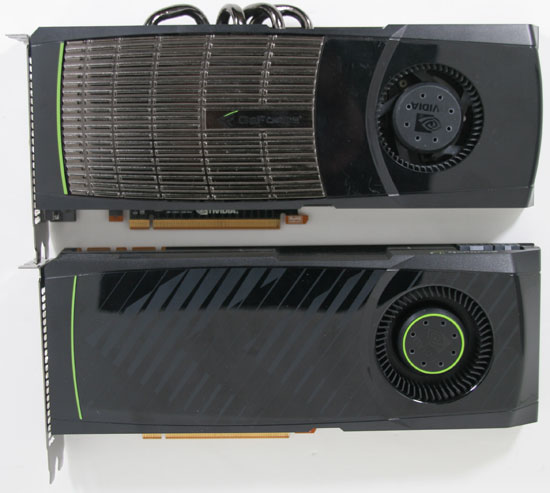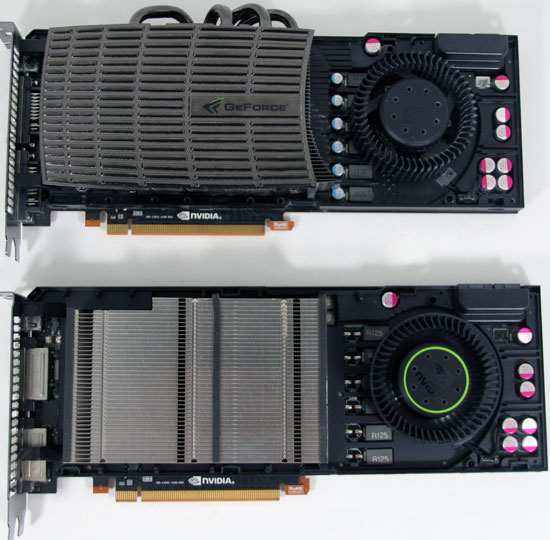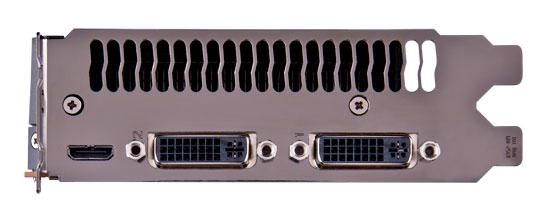NVIDIA's GeForce GTX 580: Fermi Refined
by Ryan Smith on November 9, 2010 9:00 AM ESTMeet the GTX 580
Since we’ve already discussed the cooling, let’s dive right in to the rest of the GTX 580, shall we?
Launching today will be a single GTX 580 design, the reference design. Talking to our contacts, semi-custom designs (designs using the reference PCB with a different cooler) are due in the next few weeks assuming everything goes to plan and of course there’s ample supply. And while we’re on that note, NVIDIA let us know that with their focus on cooling on the GTX 580 they aren’t going to be letting custom GTX 580 designs go out without a more thorough inspection. The acoustic performance of the reference GTX 580 is going to be the bare minimum to get a design approved – if it can’t beat the reference design, NVIDIA won’t allow it. We consider this a matter of brand protection for the company, as a bad/loud GeForce is still a GeForce all the same.

Top: GTX 480. Bottom: GTX580
With the reference design the resulting card is very close to being a GTX 285/480 hybrid. In terms of overall design it ends up looking very similar to the GTX 285. At 10.5” long it’s the same length as the GTX 480 or a smidge longer than the GTX 285, and should fit in to any cases those cards could work in. Power connectivity is the same as the GTX 480, with 6pin and 8pin PCIe sockets being located at the top of the card, providing easy access to the sockets. At 244W TDP the card draws too much for 6+6, but you can count on an eventual GTX 570 to fill that niche. Meanwhile NVIDIA has kept the 480’s detachable shroud lid, meaning you can remove the cover of the shroud without disturbing the rest of the card; it’s worth noting that it’s secured with screws rather than laches this time however.

Heatsinks Exposed! Top: GTX 480. Bottom: GTX 580
On the front side of the PCB you’ll find the 12 GDDR5 chips composing the card’s 384bit memory bus. The thermal pads connecting the memory to the shroud have once again wiped out the chip markings, so we haven’t been able to determine what these chips are, although we’re confident they’re 5Gbps like in past cards. At the center of the card is the GF110 GPU encased in a metal heatspreader, a common sight for NVIDIA’s high-end GPUs. This is an A1 revision GPU, which in NVIDIA’s counting system means it’s the first tape-out. Elsewhere on the board you’ll find the 2 SLI connectors, providing support for tri-SLI on the 580. All told while the GPU has been refined, the PCB remains largely unchanged from the GTX 480 other than removing the ventilation holes – all of the ICs are in practically the same place, and even the VRM controller is the same.
Meanwhile looking at the IO bracket for the 580, we find the same configuration as we saw on the 480. Below a full-sized vent are 2 DVI ports and a mini-HDMI port. NVIDIA slightly revised their display controller for GF110/GTX580; the good news is that HDMI 1.4a is supported, the bad news is that full audio bitstreaming is not supported so it’s the same as it was on the GTX 480: 8 channel LPCM and lossy audio formats like DD+ and DTS. This actually caught us off-guard since we were expecting the full GF104 treatment here, but it just goes to show that this is a GF100-derrivative after all. Unfortunately this also extends to the number of displays supported – NVIDIA still only supports 2 displays on one card, so you need to run in SLI if you intend to take advantage of 3DVision/NVIDIA surround across 3 monitors.

Finally, it’s with some sense of irony that we find ourselves yelling more at AMD than NVIDIA for naming shenanigans this time around, considering it was NVIDIA that brought us the 8800GT/9800GT and GeForce 200/300 product naming snafus. While NVIDIA has made some changes compared to the GTX 480, it’s a very short list; shorter than even AMD’s list for the 6800 series. At the same time, at least the GTX 580 is faster than the GTX 480 versus AMD’s 6800/5800 series. Quite frankly the GTX 580 should be the GTX 485 – the few architectural changes we’ve seen do make a difference, but then NVIDIA did a whole die shrink on the GTX 280 and only got a GTX 285 out of it. Both companies seem committed to coming out with a new family of video cards this year regardless of where the GPU powering them has actually changed. Ultimately the GTX 580 is the second flimsiest excuse for a new series number, next only to simply rebranding an existing GPU.











160 Comments
View All Comments
AnnonymousCoward - Wednesday, November 10, 2010 - link
I'm with you, that AMD still has a superior performance per power design. But with the 580, nvidia took Fermi from being outrageous to competitive in that category, and even wins by a wide margin with idle power. Looking at the charts, the 580 also has a vastly superior cooling system to the 5970. Mad props to nvidia for turning things around.FragKrag - Tuesday, November 9, 2010 - link
Still no SC2? :(Ryan Smith - Tuesday, November 9, 2010 - link
Honestly, I ran out of time. I need to do a massive round of SC2 benchmarking this week, at which time it will be in all regular reviews and will be in Bench.ph3412b07 - Tuesday, November 9, 2010 - link
There is always some debate as to the value of single gpu solutions vs multi gpu. I've noticed that the avg/max framerate in multi gpu setups is in fact quite good in some cases, but the min fps paints a different picture, with nearly all setups and various games being plagued by micro-stutter. Has anybody else come across this as reason to go with a more expensive single card?eXces - Tuesday, November 9, 2010 - link
Why did u not include some overclocked 5970? Like u did with GTX 460 when u reviewed 6800 series?Ryan Smith - Wednesday, November 10, 2010 - link
If you don't recall from our 5970 review, we disqualified our 5970 when running at 5870 clocks. The VRMs on the 5970 cannot keep up with the power draw on some real world applications, so it does not pass our muster at those speeds by even the loosest interpretation.529th - Tuesday, November 9, 2010 - link
I knew OCCT was a culprit of causing problems.Ph0b0s - Tuesday, November 9, 2010 - link
Was very interested to look at the review today to see how the new GTX580 and other DX11 card options are in comparison to my GTX 285 SLI setup. But unfortunately for the games I am playing BFBC2, Stalker etc and would base my descition on, I still don't know as my card is not represented. I know why,, becuase they are DX11 games and my card is DX10, but my card still runs them and I would want to know how they compare even if one is running DX10 and the other running DX11. Even Anandtech's chart system gives no measure for my cards in these games . Please sort this out. Just becuase a card does not run the latest version of directx does not mean it should be forgotten. Escpecially since the people most likley to be looking at upgrading are those with this generation of card rather than people with DX 11 hardware...mapesdhs - Wednesday, November 10, 2010 - link
Don't worry, I'll have some useful info for you soon! 8800GT vs. 4890 vs. 460, in all
three cases testing 1 & 2 cards. You should be able to eaisly extrapolate from the
results to your GTX285 vs. 580 scenario. Send me an email (mapesdhs@yahoo.com)
and I'll drop you a line when the results are up. Data for 8800 GT vs. 4890 is already up:
http://www.sgidepot.co.uk/misc/pctests.html
http://www.sgidepot.co.uk/misc/stalkercopbench.txt
but I'm adding two more tests (Unigine and X3TC).
Ian.
juampavalverde - Tuesday, November 9, 2010 - link
NVIDIA exceed AMD with this... as long as the barts should have been 6770, this fermi slight improvement just in this universe can be called 5xx series. it is just the gf100 done right, and should have been named properly, as gtx 490.